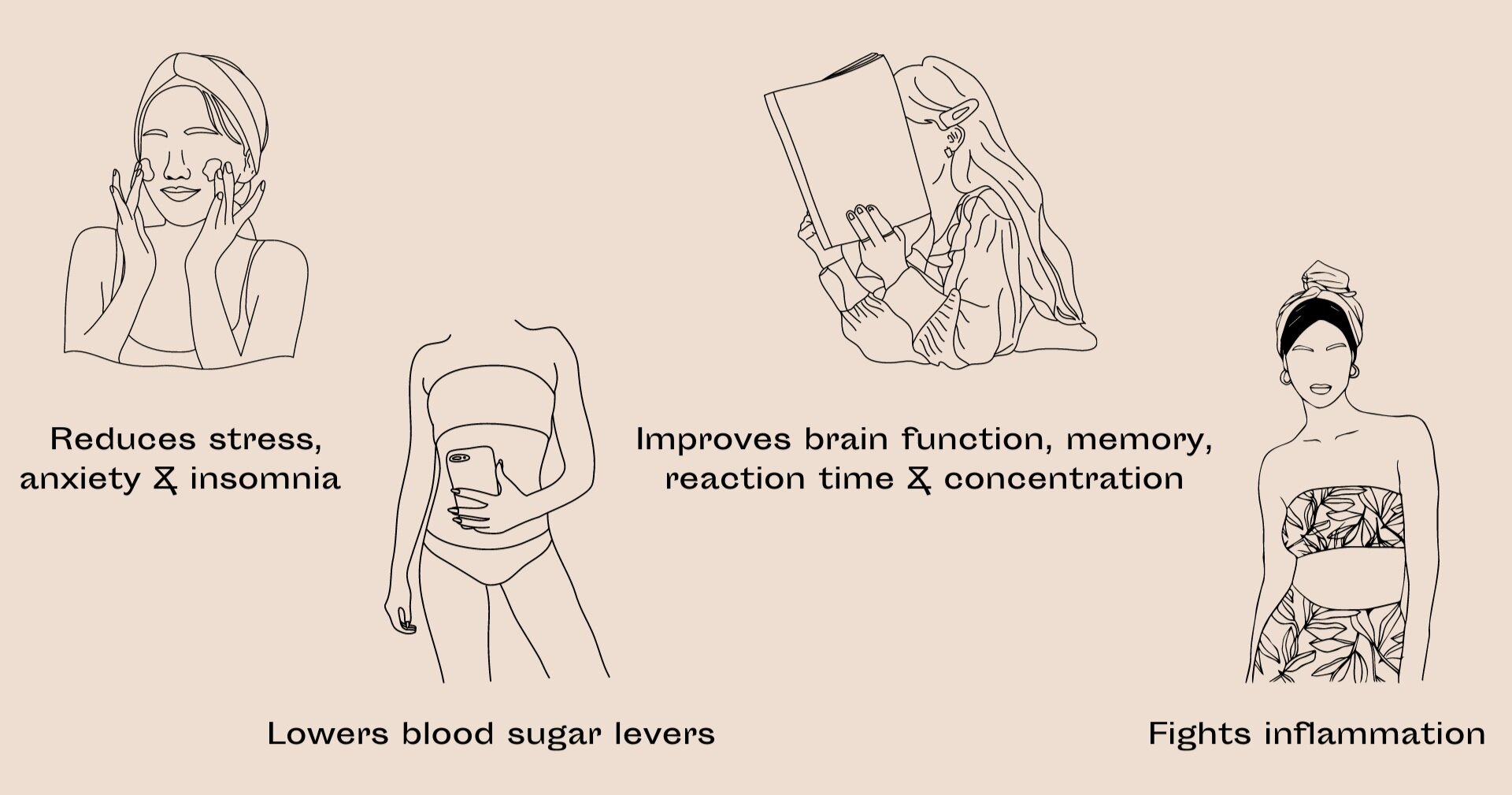Learn how ashwagandha can support the second half of the cycle
Reduces stress, anxiety & insomnia
In the second half of the cycle, oestrogen levels drop together with serotonin (mood-boosting neurotransmitter) levels. At the same time, cortisol (stress hormone) levels are elevated. This is why you may experience more stress, anxiety, mood swings, insomnia, poor concentration and other emotional PMS symptoms.
Ashwagandha, an adaptogenic herb, is best known for its ability to reduce stress.
Numerous studies have shown that ashwagandha may help lower cortisol levels and therefore can reduce stress and anxiety, improve sleep quality, and general well-being.
Lowers blood sugar levels
Prior to menstruation, you have higher insulin resistance. This can cause higher blood sugar levels if you don't make smart food choices.
Several studies suggest that ashwagandha improves insulin sensibility and secretion and therefore lowers blood sugar levels.
Fights inflammation, improves brain function, memory, reaction time & concentration
Ashwagandha increases also the activity of immune cells that fight infections and at the same time decreases inflammation, promotes antioxidant activity and protects brains cells.
This may help improve brain function, general memory, concentration and reaction time, which can be worse in the luteal phase.
Bottom line
Ashwagandha can support your body during the second half of the cycle.
But using ashwagandha alone without also eating a nutritionally-dense diet, getting enough movement and sleep won’t have much of an impact on your body.
You always should look holistically at the hormonal health. Take care of yourself both mentally and physically. Stress and other negative emotions have damaging effects on the hormonal balance and overall health.
Just be good to yourself ❤︎
Some related scientific research if you want to delve further into this subject 🤓
Stress & anxiety
Salve, J., Pate, S., Debnath, K., & Langade, D. (2019). Adaptogenic and Anxiolytic Effects of Ashwagandha Root Extract in Healthy Adults: A Double-blind, Randomized, Placebo-controlled Clinical Study. Cureus, 11(12), e6466. VIEW
Chandrasekhar, K., Kapoor, J., & Anishetty, S. (2012). A prospective, randomized double-blind, placebo-controlled study of safety and efficacy of a high-concentration full-spectrum extract of ashwagandha root in reducing stress and anxiety in adults. Indian journal of psychological medicine, 34(3), 255–262. VIEW
Cooley, K., Szczurko, O., Perri, D., Mills, E. J., Bernhardt, B., Zhou, Q., & Seely, D. (2009). Naturopathic care for anxiety: a randomized controlled trial ISRCTN78958974. PloS one, 4(8), e6628. VIEW
Andrade, C., Aswath, A., Chaturvedi, S. K., Srinivasa, M., & Raguram, R. (2000). A double-blind, placebo-controlled evaluation of the anxiolytic efficacy ff an ethanolic extract of withania somnifera. Indian journal of psychiatry, 42(3), 295–301. VIEW
Improved brain function
Pingali, U., Pilli, R., & Fatima, N. (2014). Effect of standardized aqueous extract of Withania somnifera on tests of cognitive and psychomotor performance in healthy human participants. Pharmacognosy research, 6(1), 12–18. VIEW
Choudhary, D., Bhattacharyya, S., & Bose, S. (2017). Efficacy and Safety of Ashwagandha (Withania somnifera (L.) Dunal) Root Extract in Improving Memory and Cognitive Functions. Journal of dietary supplements, 14(6), 599–612. VIEW
Kurapati, K. R., Atluri, V. S., Samikkannu, T., & Nair, M. P. (2013). Ashwagandha (Withania somnifera) reverses β-amyloid1-42 induced toxicity in human neuronal cells: implications in HIV-associated neurocognitive disorders (HAND). PloS one, 8(10), e77624. VIEW
Soman, S., Korah, P. K., Jayanarayanan, S., Mathew, J., & Paulose, C. S. (2012). Oxidative stress induced NMDA receptor alteration leads to spatial memory deficits in temporal lobe epilepsy: ameliorative effects of Withania somnifera and Withanolide A. Neurochemical research, 37(9), 1915–1927. VIEW
Inflammation
Bhat, J., Damle, A., Vaishnav, P. P., Albers, R., Joshi, M., & Banerjee, G. (2010). In vivo enhancement of natural killer cell activity through tea fortified with Ayurvedic herbs. Phytotherapy research : PTR, 24(1), 129–135. VIEW
Mikolai, J., Erlandsen, A., Murison, A., Brown, K. A., Gregory, W. L., Raman-Caplan, P., & Zwickey, H. L. (2009). In vivo effects of Ashwagandha (Withania somnifera) extract on the activation of lymphocytes. Journal of alternative and complementary medicine (New York, N.Y.), 15(4), 423–430. VIEW
Khan, M. A., Subramaneyaan, M., Arora, V. K., Banerjee, B. D., & Ahmed, R. S. (2015). Effect of Withania somnifera (Ashwagandha) root extract on amelioration of oxidative stress and autoantibodies production in collagen-induced arthritic rats. Journal of complementary & integrative medicine, 12(2), 117–125. VIEW
Blood sugar levels
Agnihotri, A. P., Sontakke, S. D., Thawani, V. R., Saoji, A., & Goswami, V. S. (2013). Effects of Withania somnifera in patients of schizophrenia: a randomized, double blind, placebo controlled pilot trial study. Indian journal of pharmacology, 45(4), 417–418. VIEW
Gorelick, J., Rosenberg, R., Smotrich, A., Hanuš, L., & Bernstein, N. (2015). Hypoglycemic activity of withanolides and elicitated Withania somnifera. Phytochemistry, 116, 283–289. VIEW
Andallu, B., & Radhika, B. (2000). Hypoglycemic, diuretic and hypocholesterolemic effect of winter cherry (Withania somnifera, Dunal) root. Indian journal of experimental biology, 38(6), 607–609. VIEW
Samadi Noshahr, Z., Shahraki, M. R., Ahmadvand, H., Nourabadi, D., & Nakhaei, A. (2015). Protective effects of Withania somnifera root on inflammatory markers and insulin resistance in fructose-fed rats. Reports of biochemistry & molecular biology, 3(2), 62–67. VIEW

